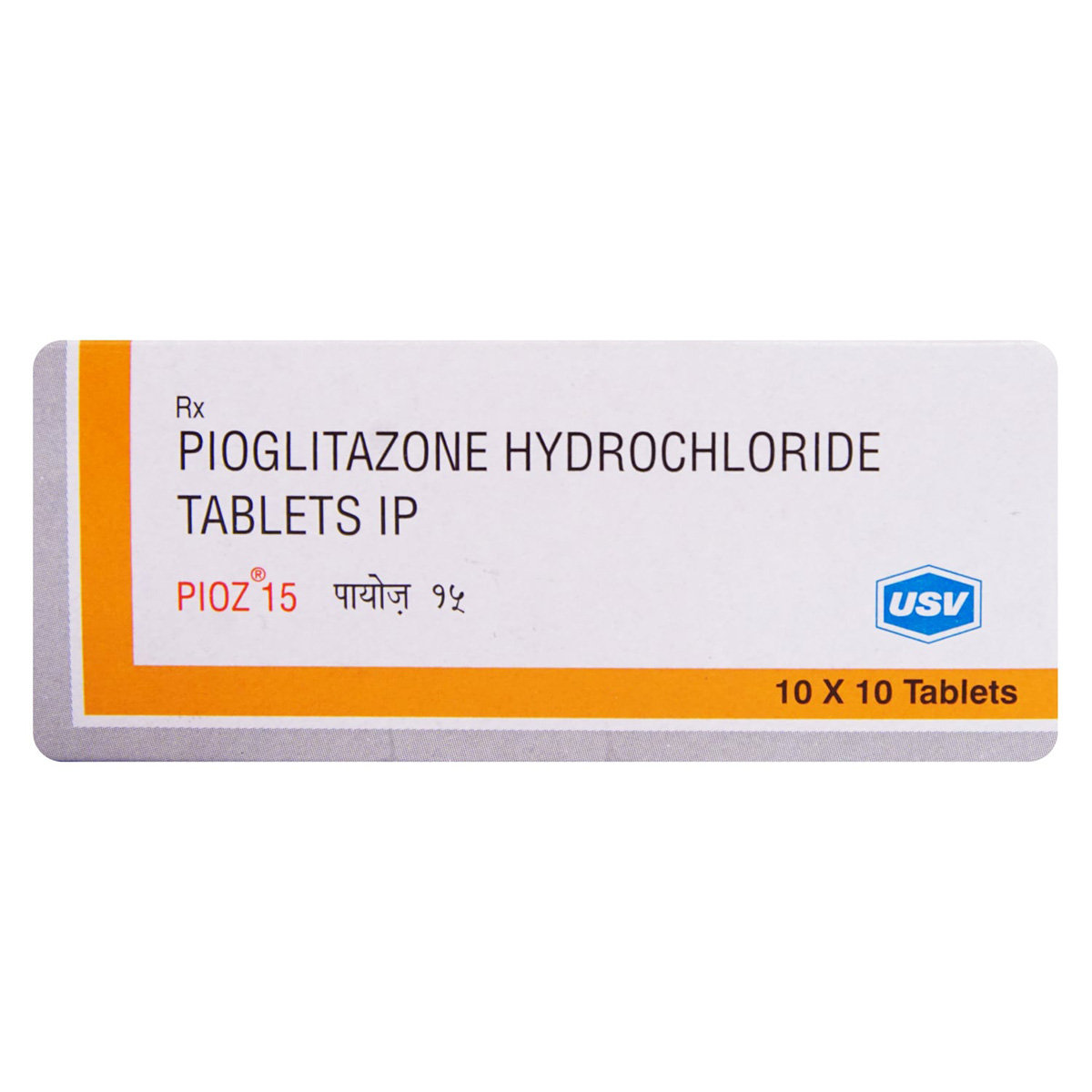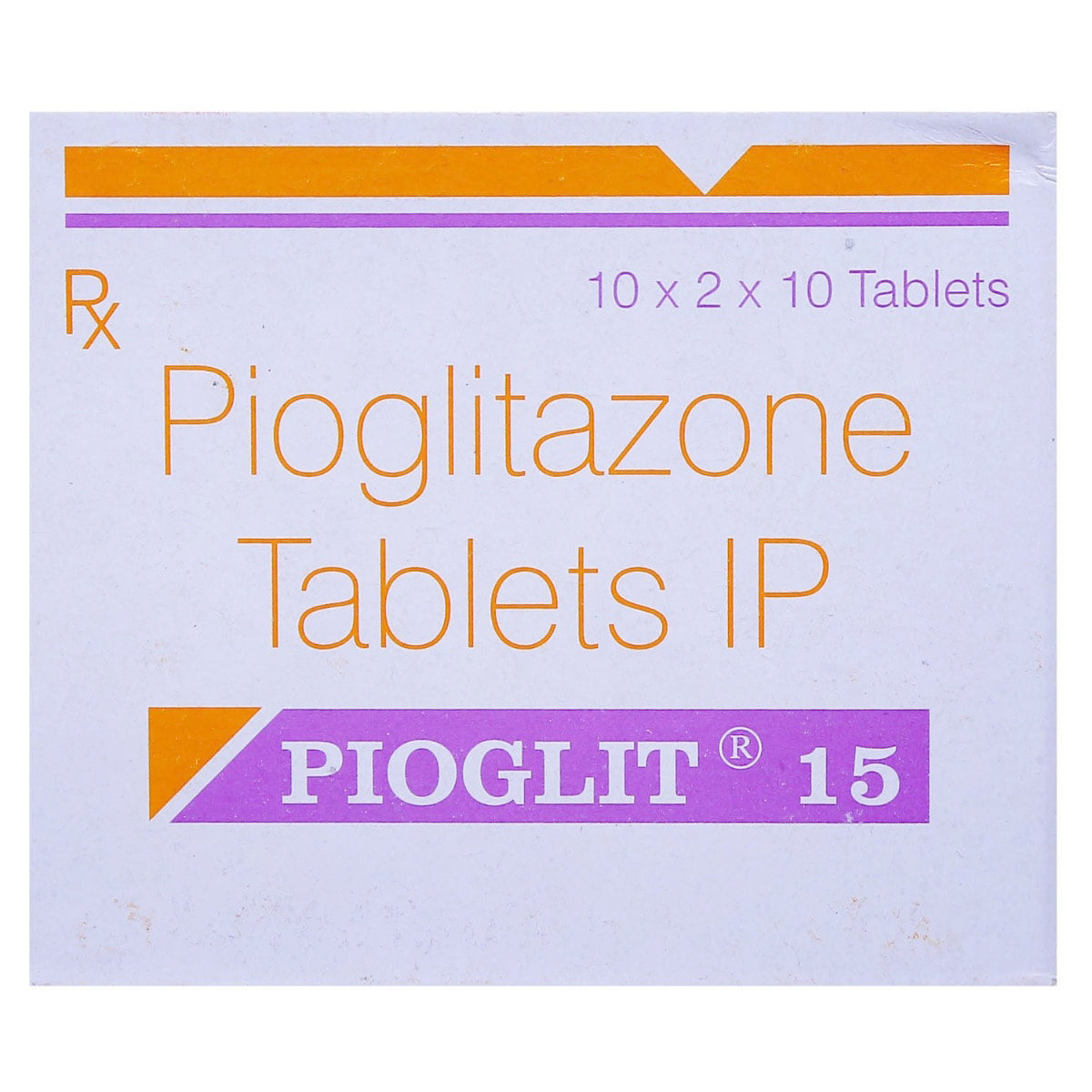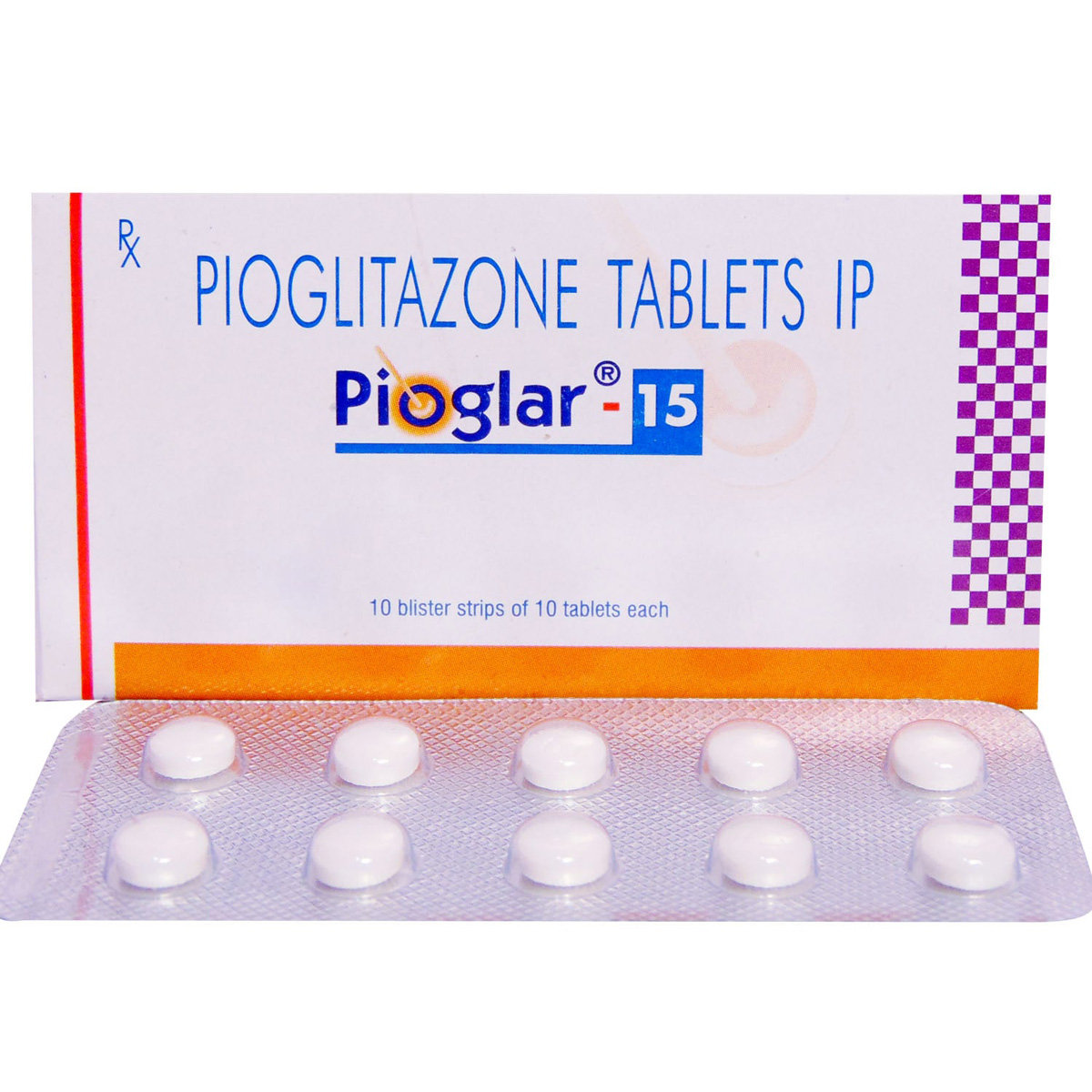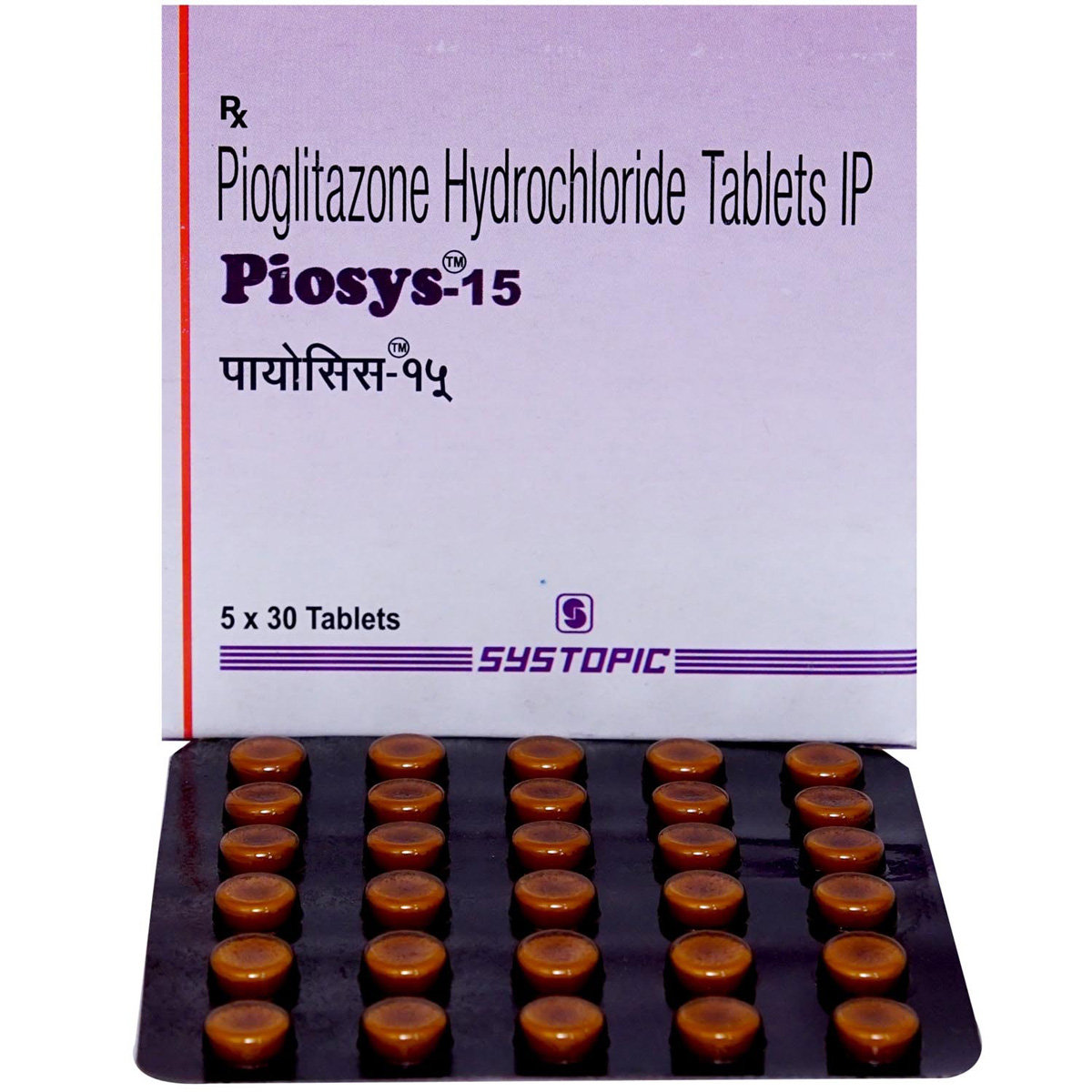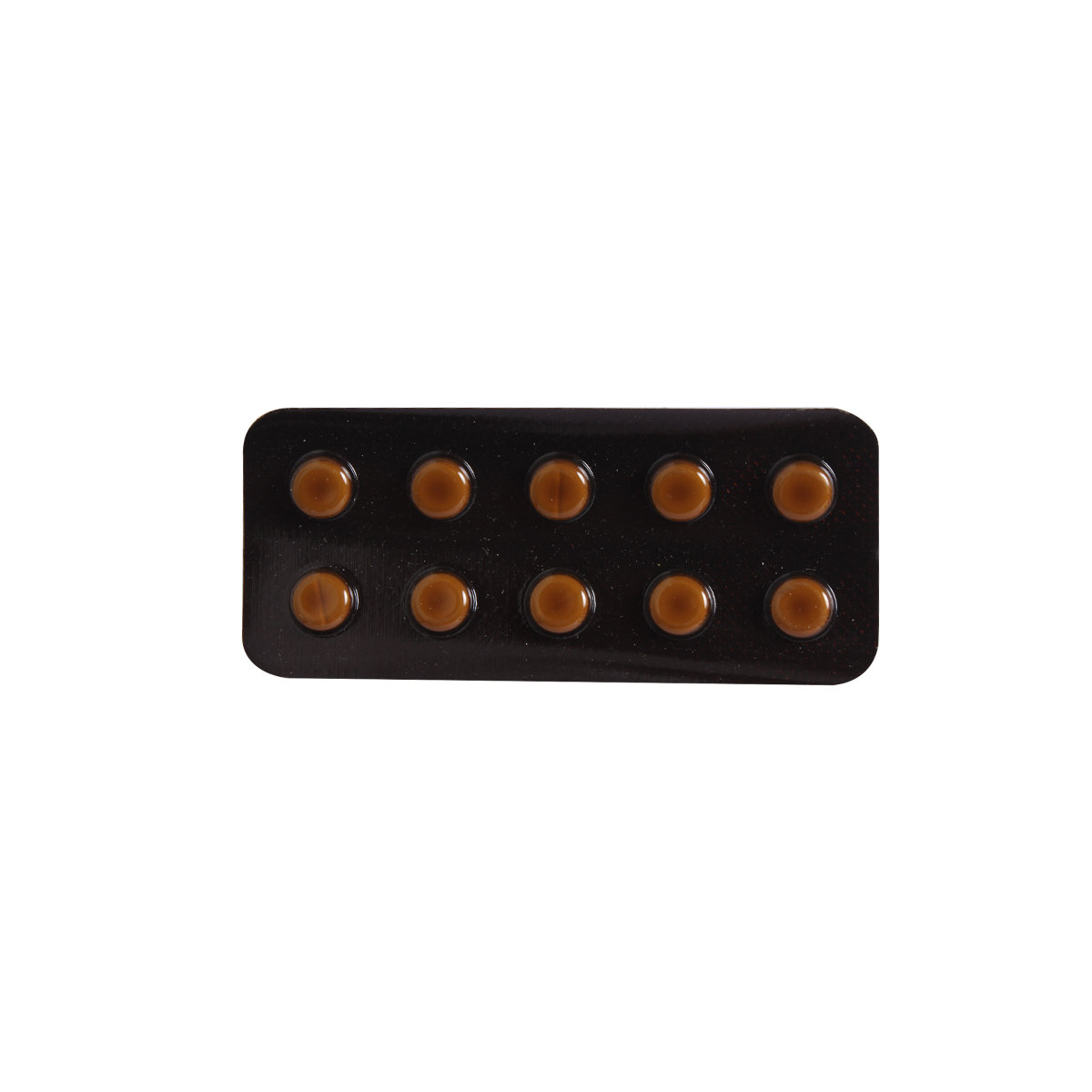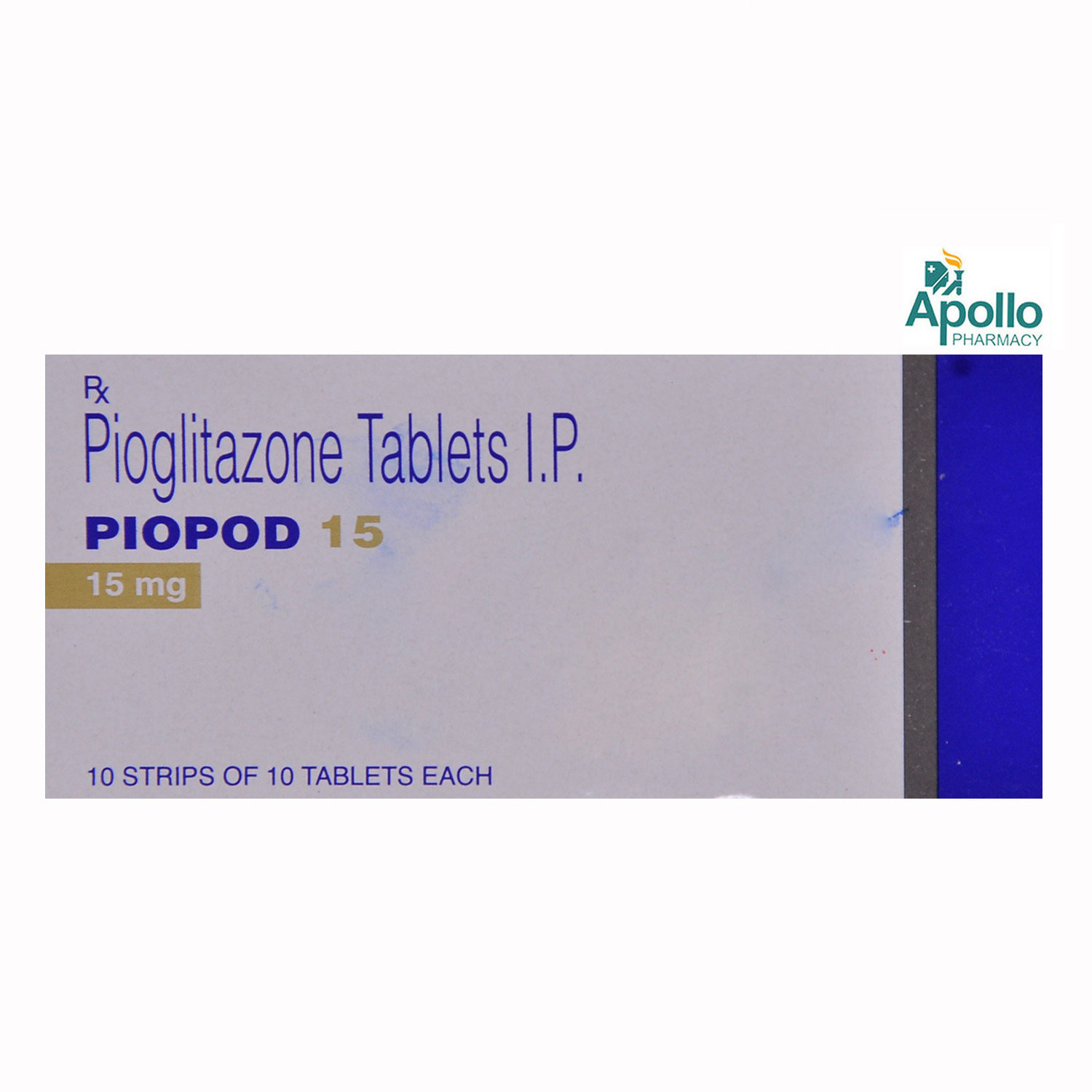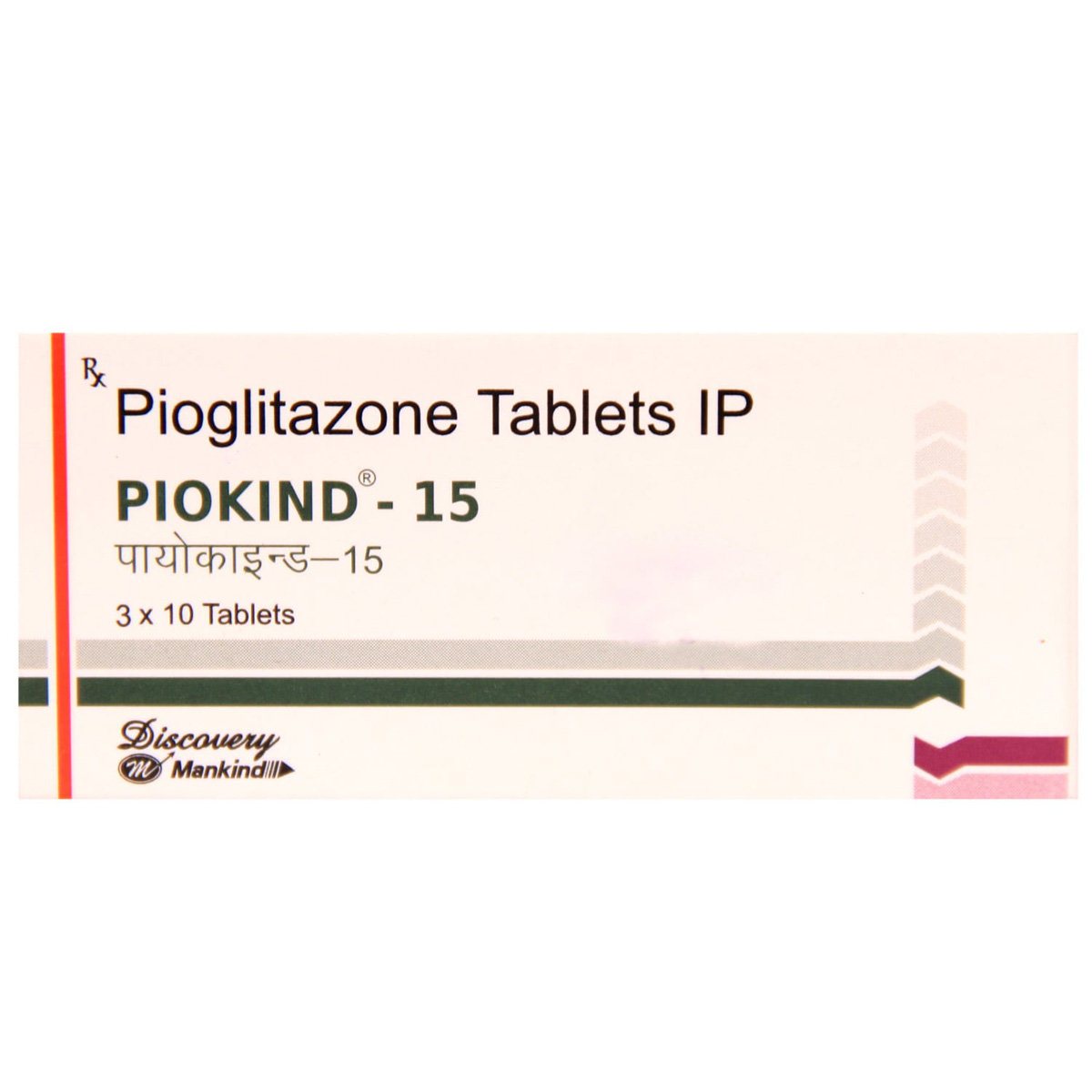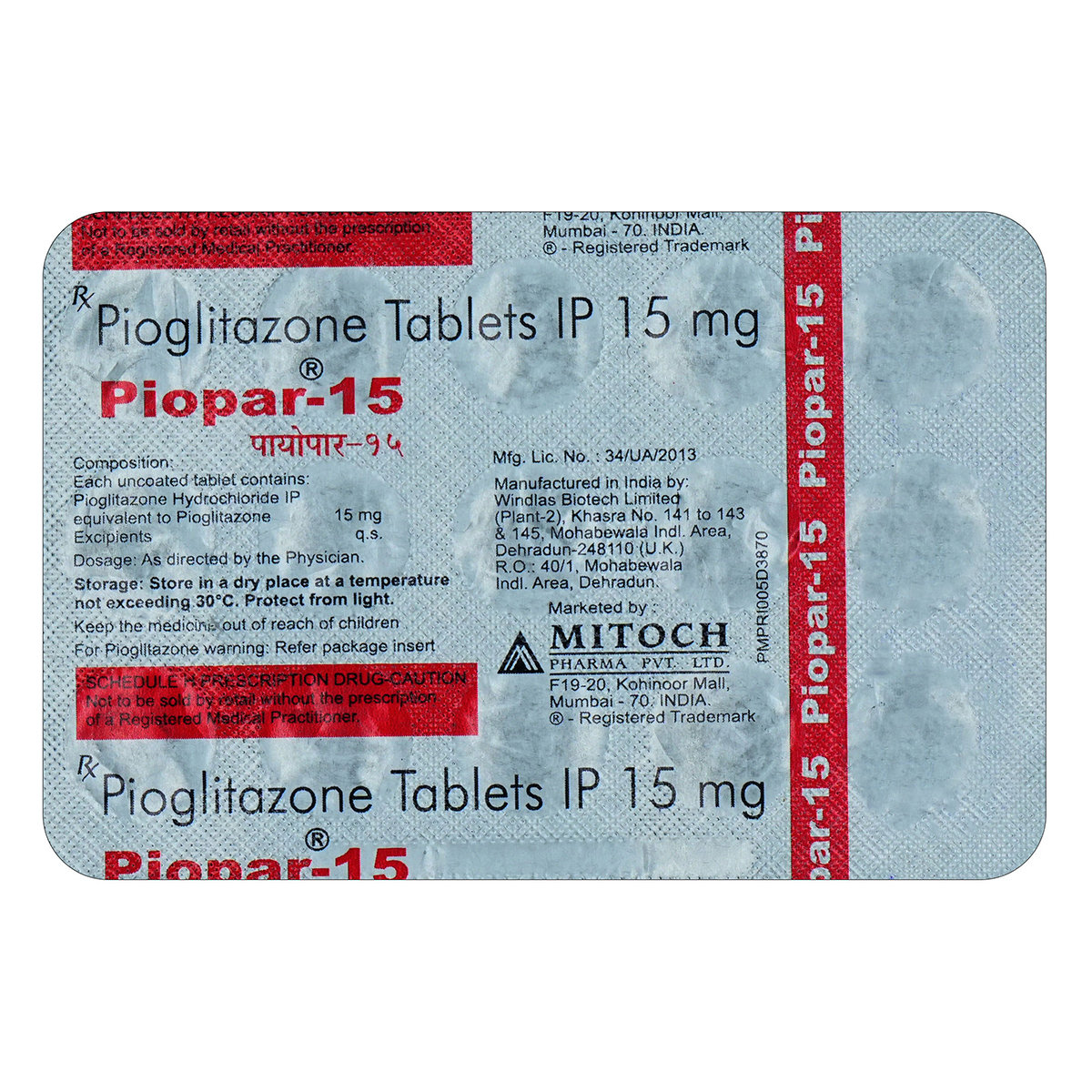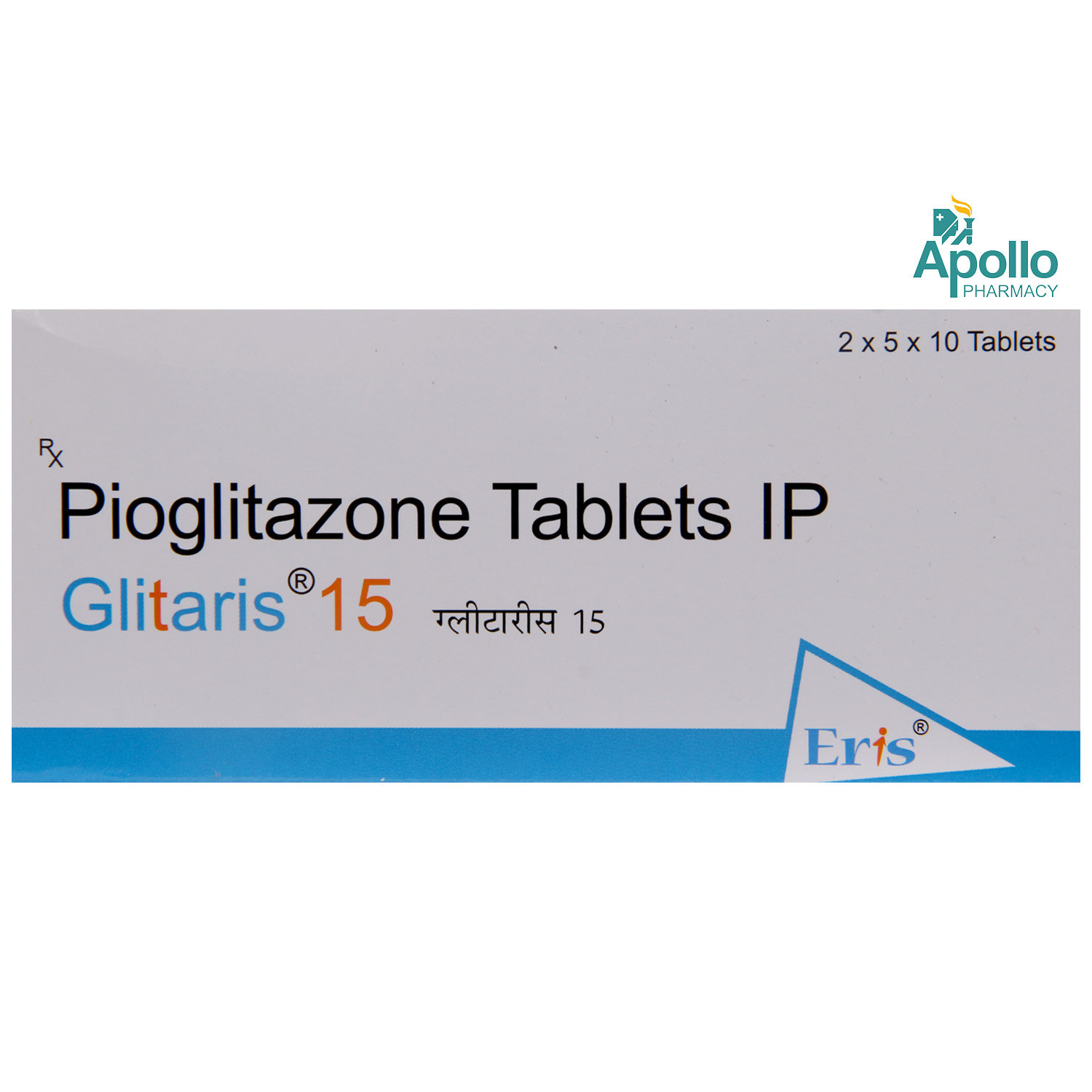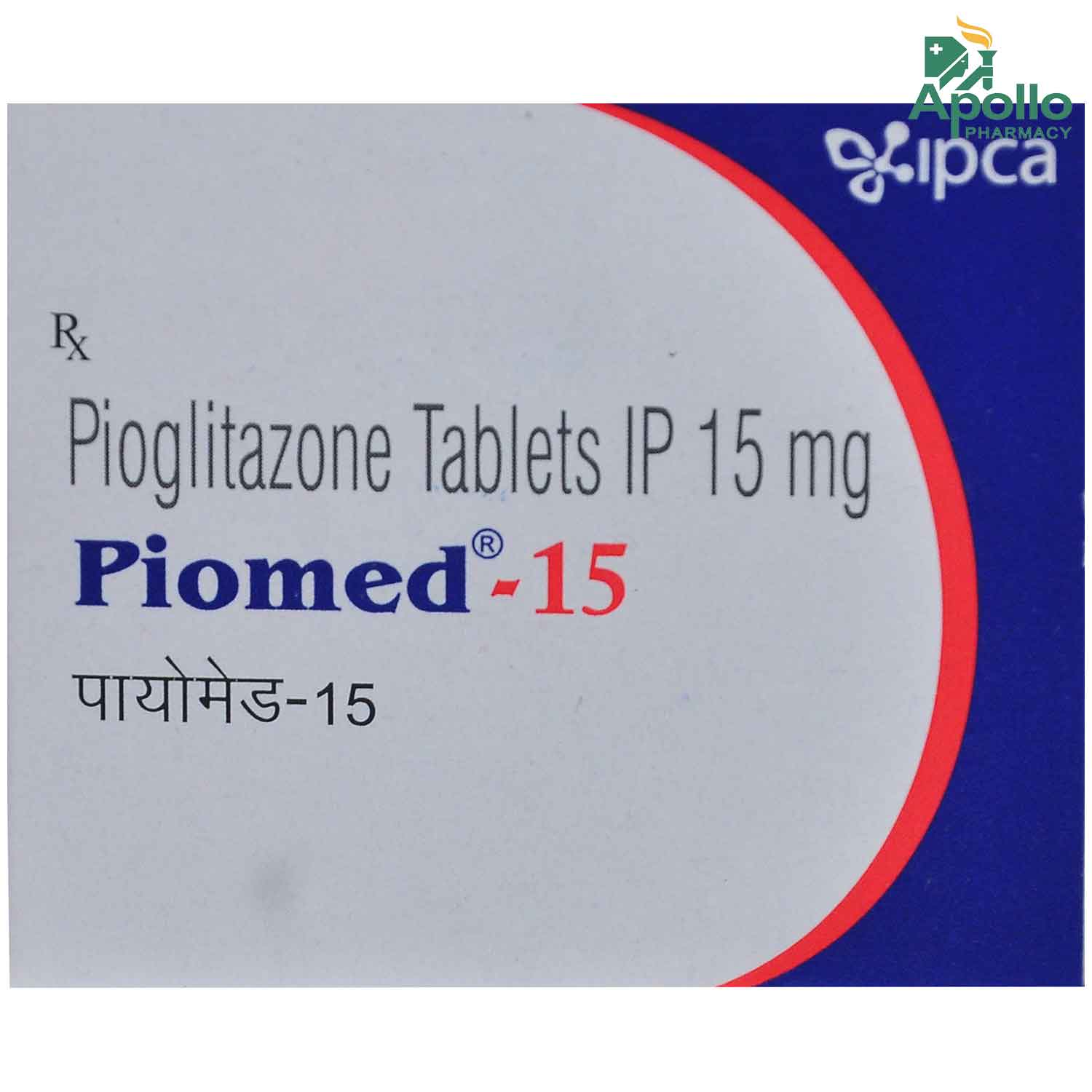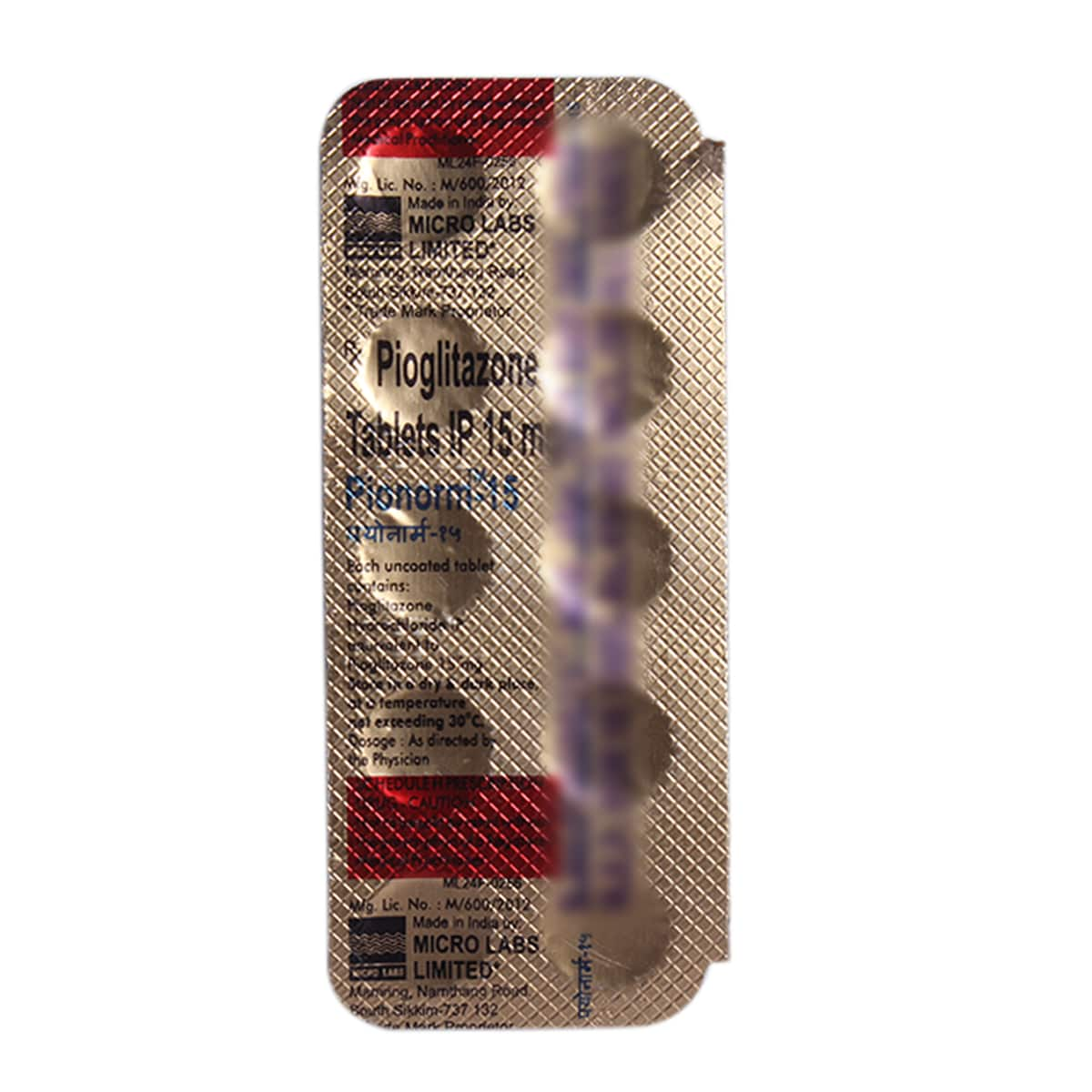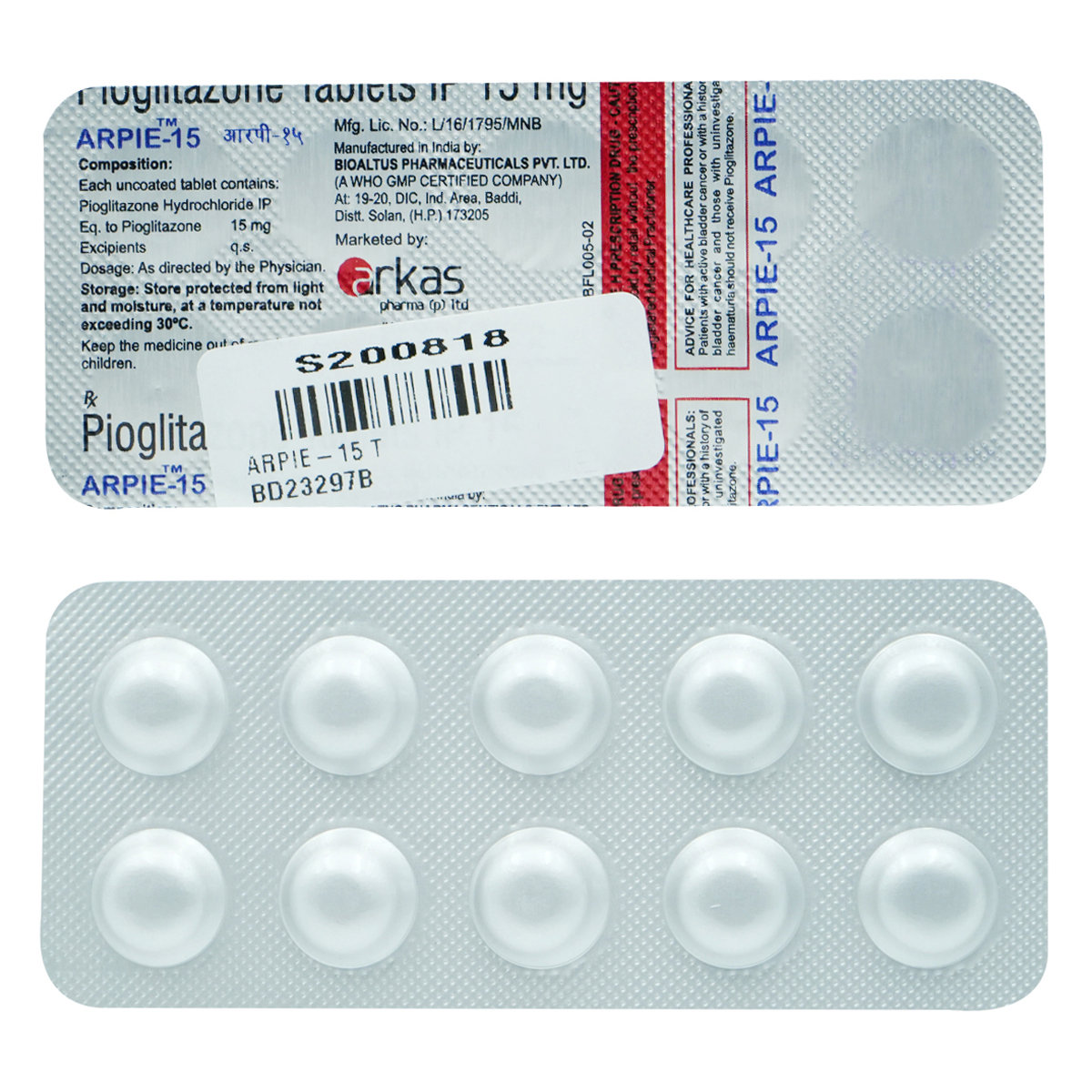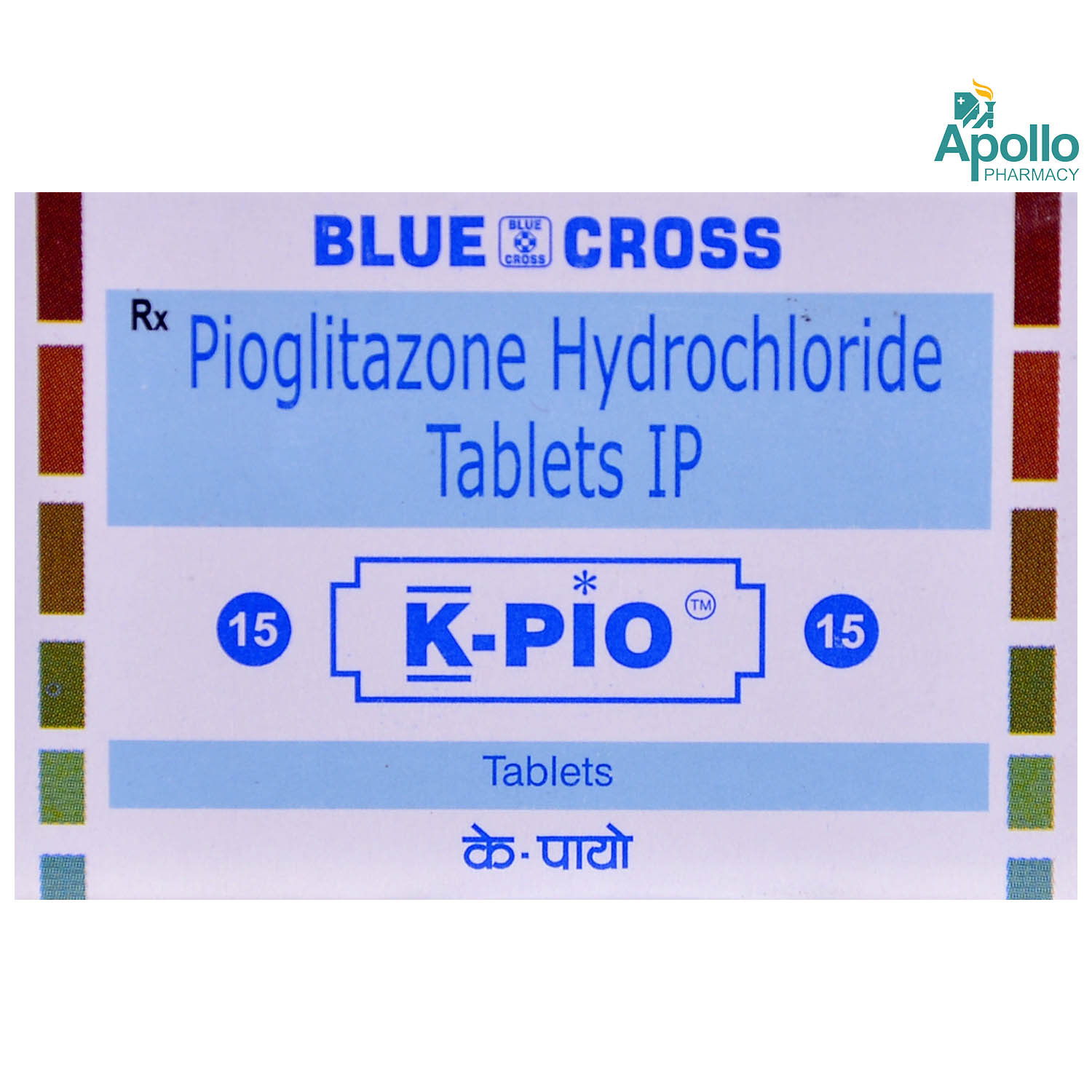GP 15 Tablet 10's

MRP ₹48.5
(Inclusive of all Taxes)
₹7.3 Cashback (15%)
Provide Delivery Location
Online payment accepted
 Prescription drug
Prescription drugWhats That
Composition :
Manufacturer/Marketer :
Consume Type :
Return Policy :
Expires on or after :
About GP 15 Tablet
GP 15 Tablet is an anti-diabetic medicine belonging to the class of thiazolidinedione (TZD), also called 'glitazones', used to treat type 2 (non-insulin-dependent) diabetes mellitus. Type 2 diabetes is an illness where the body doesn't make enough insulin, or the insulin that it makes doesn't work properly. This is diabetes that usually develops in adulthood.
GP 15 Tablet contains Pioglitazone which helps control the sugar level in your blood when you have type 2 diabetes by helping your body make better use of the insulin it produces. Your doctor will check whether Pioglitazone is working 3-6 months after you start taking it.
GP 15 Tablet should be taken with food or an empty stomach. However, it should be taken at the same time of the day each time for the best results. For better advice, your doctor will decide what dose should be taken, which can change quickly depending on your condition. The most common side effect of GP 15 Tablet is upper respiratory tract infection, headache, sinusitis, myalgia (muscle pain), and pharyngitis. Most of these side effects of GP 15 Tablet do not require medical attention and gradually resolve over time. Please consult your doctor if these side effects become troublesome.
GP 15 Tablet should not be stopped even if you feel better without consulting your doctor as sugar levels change. If you stop taking GP 15 Tablet suddenly, it may increase your sugar levels which could further increase the risk of eyesight loss (retinopathy), kidney damage (nephropathy) and nerve damage (neuropathy). GP 15 Tablet should not be taken if you have type 1 diabetes mellitus, if you are hypersensitive (allergic) to GP 15 Tablet or any of the other ingredients of GP 15 Tablet , have heart failure or have had heart failure in the past, diabetic ketoacidosis (a complication of diabetes causing rapid weight loss, nausea or vomiting), severe kidney or liver disease, bladder cancer. Please inform your doctor if you have any heart disease, are or planning to get pregnant or breastfeeding. The safety and efficacy of GP 15 Tablet in children under 18 years have not been established, so it should not be given to them.
Uses of GP 15 Tablet
Directions for Use
Medicinal Benefits
GP 15 Tablet is an antidiabetic drug (thiazolidinedione/glitazones) used along with a proper diet and exercise to control high blood sugar (hyperglycaemia) in patients with type 2 diabetes. GP 15 Tablet works by helping to restore your body's appropriate response to insulin, thereby lowering your blood sugar.
Storage
Drug Warnings
Fluid retention (oedema) may occur and can lead to congestive heart failure so, a combination of use with insulin and use in heart failure may increase the risk in patients taking GP 15 Tablet . You should not take GP 15 Tablet if you have kidney disease, as measured by a blood test. GP 15 Tablet , when used with or without insulin, $ name tends to lower the blood sugar level. So, the doctor may lower the dose of insulin. Increased fractures may be reported in some women taking GP 15 Tablet . Patients with bladder cancer and macular oedema (fluid build-up in the macula part of the retina of the eye) should consult the doctor before using GP 15 Tablet .
Drug-Drug Interactions
Drug-Drug Interactions
Login/Sign Up
Taking indomethacin with GP 15 Tablet may increase the risk of low blood sugar.
How to manage the interaction:
Although there is a possible interaction, GP 15 Tablet can be taken with indomethacin if prescribed by the doctor. Consult the doctor if you experience symptoms of low blood sugar such as headache, dizziness, drowsiness, nervousness, confusion, tremor, nausea, hunger, weakness, perspiration, palpitation, and rapid heartbeat.
Co-administration of Moxifloxacin can affect blood glucose levels. Both high blood glucose and low blood glucose.
How to manage the interaction:
Although there is a possible interaction, GP 15 Tablet can be taken with Moxifloxacin if prescribed by the doctor. Consult the doctor if you experience headache, dizziness, rapid heartbeat, increased thirst, and increased urination. Do not discontinue the medications without consulting a doctor.
Taking GP 15 Tablet with Sulfadiazine may increase the risk of low blood sugar.
How to manage the interaction:
Although there is a possible interaction, GP 15 Tablet can be taken with sulfadiazine if prescribed by the doctor. Consult the prescriber if you experience symptoms of low blood sugar such as headache, dizziness, drowsiness, nervousness, confusion, tremor, nausea, hunger, weakness, perspiration, palpitation, and rapid heartbeat. Do not discontinue the medications without consulting a doctor. Do not discontinue the medications without consulting a doctor.
Co-administration of Furosemide may interfere with blood glucose control and lower the effectiveness of GP 15 Tablet.
How to manage the interaction:
Although there is a possible interaction, GP 15 Tablet can be taken with furosemide if prescribed by the doctor. Regular monitoring of blood glucose levels is advised. Do not discontinue the medications without consulting a doctor.
When GP 15 Tablet is taken with Nalidixic acid, can sometimes affect blood glucose levels. Both hyperglycemia (high blood glucose) and, less frequently, hypoglycemia (low blood glucose) have been reported.
How to manage the interaction:
There may be a possibility of interaction between GP 15 Tablet and Nalidixic acid, but it can be taken if prescribed by a doctor. It's important to monitor your blood sugar levels closely. If you experience symptoms like kidney problems, low or high blood sugar, or other concerning symptoms, contact a doctor right away. They may be able to suggest alternative medications that won't interact with a diabetes treatment. Do not discontinue any medications without consulting a doctor.
When GP 15 Tablet is taken with Thioridazine may interfere with blood glucose control and reduce the effectiveness of GP 15 Tablet.
How to manage the interaction:
Taking GP 15 Tablet with Thioridazine together can possibly result in an interaction, but it can be taken if a doctor has advised it. If you notice any of these signs - really high or low blood sugar levels - make sure to contact a doctor right away. Do not stop using any medications without a doctor's advice.
Taking GP 15 Tablet with Enoxacin, may affect blood glucose levels which may lead to hypoglycemia (low blood glucose) and hyperglycemia (high blood glucose).
How to manage the interaction:
Taking GP 15 Tablet with Enoxacin together can possibly result in an interaction, but it can be taken if a doctor has advised it. This can be a good thing if you need help lowering your blood sugar, but it can also be a problem if it goes too low. If you notice any of these symptoms, it's important to contact a doctor right away. Do not stop using any medications without a doctor's advice.
Co-administration of Diethylstilbestrol may interfere with blood glucose control and reduce the effectiveness of GP 15 Tablet.
How to manage the interaction:
Although there is a possible interaction between GP 15 Tablet and Diethylstilbestrol, you can take these medicines together if prescribed by a doctor. It's important to keep an eye on how much urine you're producing. If you notice any of these signs - very high or very low blood sugar levels - make sure to contact a doctor right away. Do not stop using any medications without talking to a doctor.
Co-administration of Ofloxacin and GP 15 Tablet can sometimes have an effect on blood glucose levels.
How to manage the interaction:
Although combining Ofloxacin and GP 15 Tablet can lead to an interaction, they can be taken on a doctor's advice. If you experience any symptoms of hypoglycemia (headache, dizziness, sleepiness, nervousness, confusion, shaking, nausea, hunger, weakness, sweat, palpitation, and rapid heartbeat) or hyperglycemia (increased thirst, hunger, and urination), consult a doctor. Keep an eye on your blood glucose level. Do not discontinue any medications without consulting a doctor.
Bumetanide may interfere with blood glucose control and reduce the effectiveness of GP 15 Tablet.
How to manage the interaction:
Although there is a possible interaction, GP 15 Tablet can be taken with bumetanide if prescribed by the doctor. Monitoring of blood glucose levels is advised.
Drug-Food Interactions
Drug-Food Interactions
Login/Sign Up
Diet & Lifestyle Advise
- Fill your half plate with starchy veggies, a quarter with proteins, and a quarter with whole grain.
- Eat at regular interval. Do not take the long gap between a meal or snack.
- Monitor your blood sugar level regularly especially when there are a lot of fluctuations.
- Invest at least 150 min of moderate-intensity physical activity and 15 minutes of high-intensity exercise every week.
- Lose weight gradually to achieve a healthy body mass index (18.5 to 24.9).
- Replace refined carbohydrates containing foods with whole grain foods and increase intake of fruits and veggies and other fibre enriched foods.
- Reduce intake of saturated fat (or hidden fats) in the food like chips, crisps, pastries, biscuits and samosas. Choose omega 3 fatty acid-containing oils for daily cooking. For frying, you may use palm oil, mustard oil, groundnut oil, rice bran oil, and safflower oil.
- Do not take stress as it may elevate your blood sugar level. You may adopt stress management techniques like mindfulness, yoga or meditation to control stress-related to blood sugar changes.
- Opt for low-fat dairy products (low-fat yoghurt, fat-free milk and cheese etc.).
- Keep your blood pressure as normal (120/80) as possible. As it reduces the risk of cardiovascular diseases in diabetes patients.
Side Effects of GP 15 Tablet
- Upper respiratory tract infection
- Headache
- Sinusitis
- Myalgia (muscle pain)
- Pharyngitis (inflammation of pharynx located back of neck)
Habit Forming
Therapeutic Class
Product Substitutes
Author Details
We provide you with authentic, trustworthy and relevant information
Drug-Diseases Interactions
Drug-Diseases Interactions
Login/Sign Up
When compared to diet alone or diet plus insulin, the use of oral hypoglycemic medications may be associated with an increased risk of cardiovascular mortality. This alert is based on the University Group Diabetes Programme (UGDP) project, a long-term prospective clinical investigation aimed to assess the efficacy of glucose-lowering medications in preventing or delaying vascular problems in non-insulin-dependent diabetes patients. Patients treated for 5 to 8 years with diet with a fixed dose of either tolbutamide (a sulfonylurea) or phenformin (a biguanide) had a cardiovascular death risk nearly 2.5 times that of patients treated with diet alone, resulting in the cessation of both therapies in the research. Regardless of how these findings are interpreted, doctors and patients should be aware of the possibility.
How to manage the interaction:
The use of oral hypoglycemic agents may be associated with an increased risk of heart problems. Let the doctor know if you have heart problems.
Sulfonylureas are metabolised in the liver and eliminated in the urine and faeces as metabolites (some of which have pharmacologic activity). Patients with poor liver and/or renal function who are treated with sulfonylureas may be exposed to increased serum drug concentrations, increasing the risk of severe hypoglycemia episodes. In the context of hepatic impairment, gluconeogenic ability may be reduced, adding to the risk. Sulfonylurea therapy should be used with caution in people who have liver or kidney illness. It is possible that lower dosages and longer intervals between dosage adjustments will be required. If hypoglycemia occurs during treatment, it may be prolonged in these patients due to slower medication metabolism and/or excretion.
How to manage the interaction:
In patients with kidney problems, severe hypoglycemic episodes may occur. Therapy should be administered cautiously in patients with renal disease.
Hypoglycemia is a common side effect of insulin and/or oral hypoglycemic medications. Patients who are debilitated or malnourished, those with defective counterregulatory mechanisms (e.g., autonomic neuropathy and adrenal or pituitary insufficiency), and those receiving beta-adrenergic blocking agents should exercise caution when using these drugs.
How to manage the interaction:
Care should be taken in patients who may be particularly susceptible to the development of hypoglycemic episodes during treatment.
In patients with glucose 6-phosphate dehydrogenase (G6PD) impairment, sulfonylureas can cause hemolytic anaemia. In individuals with G6PD deficiency, these medicines should be administered with caution, and a non-sulfonylurea option should be considered. Postmarketing reports of hemolytic anaemia in patients receiving these medications who did not have known G6PD deficiency have been received.
How to manage the interaction:
Therapy should be used with caution in patients with glucose 6-phosphate dehydrogenase (G6PD) deficiency. The use of a non-sulfonylurea alternative should be considered.
Treatment with sulfonylureas may cause hyponatremia in individuals who are taking other drugs or have medical disorders that cause hyponatremia, or it may stimulate the secretion of antidiuretic hormone. Certain sulfonylureas have been linked to the syndrome of inappropriate antidiuretic hormone (SIADH) secretion, and these medications may enhance the peripheral (antidiuretic) action of ADH and/or increase ADH release. Caution should be exercised when treating individuals who have hyponatremia or are at increased risk of developing hyponatremia, such as the elderly, those using diuretics, or those who are volume-depleted.
How to manage the interaction:
Caution should be used when treating patients with low sodium or at greater risk of developing low sodium such as elderly patients, patients taking diuretics or those who are volume-depleted.
FAQs
Type-2 diabetes generally does not affect healthy children and teens, but it may affect children who are obese, which is also known as Childhood Obesity.
Hypoglycemia refers to low blood sugar levels, and it is one of the side effects of GP 15 Tablet . Hypoglycemia can occur if you miss or delay your food, drink alcohol, over-exercise or take other antidiabetic medicine along with this medicine. It is important to monitor blood sugar levels regularly.
If you have symptoms like increased hunger, increased thirst, frequent urination (usually at night), unexplained weight loss, fatigue, blurred vision, slow wound/sores healing, and frequent infections, contact doctor as it can be a condition of type 2 diabetes.
In case you feel that your blood sugar level is going down and you are feeling weak, immediately eat sugar candies or drink sugary beverages. It will help to balance the blood sugar level in your body. So, it is advisable to keep sugar candies with you.
Yes, Metformin and Pioglitazone is a combination of two oral diabetes medicines that help control blood sugar levels. Metformin and pioglitazone are used together with diet and exercise to improve blood sugar control in adults with type 2 diabetes mellitus who do not use daily insulin injections.
If you have or have ever had urinary bladder cancer, diabetic eye disease (retinopathy), or kidney or liver disease, avoid use of GP 15 Tablet . If it is urgent consult with the doctor.
Drug-Drug Interactions Checker List
- GEMFIBROZIL
- RIFAMPICIN
Special Advise
- Keep taking the drug even if you think your blood sugar levels are under control. If you miss a dose, do not take a larger dose. Consult your treating physician for advice.
- Take short, frequent meals, and avoid prolonged fasting when taking this drug. Beware of symptoms of hypoglycaemia which include sweating, dizziness, palpitations, shivering, intense thirst, dry mouth, dry skin, frequent urination etc. Whenever you experience the symptoms mentioned above, immediately consume 5-6 candies, three glucose biscuits, or three teaspoons of honey/sugar and get in touch with your physician. Make sure to carry these with you at all times, especially for long travels.
- Before the doctor prescribes this medicine, it is always better that your physician knows about any underlying conditions like kidney or liver disease, prior heart attack, alcohol intake, etc.
- Avoid drinking alcohol while on this drug as it increases the risk of hypoglycaemia (decrease in blood sugar which might be fatal in some cases) and lactic acidosis (when the lactic acid increases in the body, which impacts the functioning of various organs in the body).
- Try to quit smoking and reduce your intake of carbohydrate-rich food like potatoes, rice, mangoes, bread, sugar etc.
Disease/Condition Glossary
Type 2 diabetes is a chronic or lifelong disease that keeps the body away from properly utilizing insulin. Hence, people affected with type 2 diabetes either do not produce enough insulin or resist insulin action. Middle-aged or older are most likely to suffer from type 2 diabetes, also known as adult-onset diabetes. Symptoms of type 2 diabetes include increased thirst, frequent urination at night, slow wound healing, increased hunger, fatigue, and blurred vision. There may be weight gain in some cases, while weight loss may be observed in rare cases. The complication of type 2 diabetes also includes neuropathy (nerve problems), nephropathy (kidney problems), and retinopathy (damaged retina of eyes or blindness), loss of limbs, sexual dysfunction, and increase the chance of heart attack or stroke.

Have a query?
Buy best Diabetics products by
Torrent Pharmaceuticals Ltd
Sun Pharmaceutical Industries Ltd
Eris Life Sciences Ltd
Intas Pharmaceuticals Ltd
Lupin Ltd
Micro Labs Ltd
Mankind Pharma Pvt Ltd
Lloyd Healthcare Pvt Ltd
Alkem Laboratories Ltd
Abbott India Ltd
Glenmark Pharmaceuticals Ltd
Cipla Ltd
Macleods Pharmaceuticals Ltd
Wockhardt Ltd
Dr Reddy's Laboratories Ltd
Primus Remedies Pvt Ltd
USV Pvt Ltd
Aristo Pharmaceuticals Pvt Ltd
Emcure Pharmaceuticals Ltd
Alembic Pharmaceuticals Ltd
Ipca Laboratories Ltd
La Renon Healthcare Pvt Ltd
Ajanta Pharma Ltd
Medley Pharmaceuticals Ltd
East West Pharma India Pvt Ltd
Elbrit Life Sciences Pvt Ltd
Corona Remedies Pvt Ltd
Hbc Life Sciences Pvt Ltd
Sinsan Pharmaceuticals Pvt Ltd
Ranmarc Labs
Mitoch Pharma Pvt Ltd
Zydus Healthcare Ltd
Sanofi India Ltd
Akumentis Healthcare Ltd
Fusion Health Care Pvt Ltd
Unison Pharmaceuticals Pvt Ltd
Jubilant Lifesciences Ltd
Novo Nordisk India Pvt Ltd
Tas Med India Pvt Ltd
Blue Cross Laboratories Pvt Ltd
Msn Laboratories Pvt Ltd
Eswar Therapeutics Pvt Ltd
Indoco Remedies Ltd
Q Check Pharmaceuticals
Alteus Biogenics Pvt Ltd
Anthem Bio Pharma
Franco Indian Pharmaceuticals Pvt Ltd
Systopic Laboratories Pvt Ltd
Panacea Biotec Ltd
Zydus Cadila
Biocon Ltd
Edoc Life Sciences Pvt Ltd
Koye Pharmaceuticals Pvt Ltd
Arkas Pharma Pvt Ltd
Diacardus Pharmacy Pvt Ltd
Elinor Pharmaceuticals (P) Ltd
Remedy Life Sciences Pvt Ltd
Saan Labs
Talent India Pvt Ltd
Jarun Pharmaceuticals Pvt Ltd
Capital Pharma
Shrrishti Health Care Products Pvt Ltd
FDC Ltd
Leeford Healthcare Ltd
Nirvana India Pvt Ltd
Elder Pharmaceuticals Ltd
Eli Lilly and Company (India) Pvt Ltd
Glynis Pharmaceuticals Pvt Ltd
Zuventus Healthcare Ltd
Arrient Healthcare Pvt Ltd
Cadomed Pharmaceuticals India Pvt Ltd
Orris Pharmaceuticals
Akesiss Pharma Pvt Ltd
Bal Pharma Ltd
Biochem Pharmaceutical Industries Ltd
Knoll Healthcare Pvt Ltd
Lippon Pharma Pvt Ltd
Morepen Laboratories Ltd
Neucure Lifesciences Pvt Ltd
Opsis Care Lifesciences Pvt Ltd
Wallace Pharmaceuticals Pvt Ltd
Acmedix Pharma Llp
Converge Biotech Pvt Ltd
Erinyle Pharma
Indiabulls Pharmaceuticals Pvt Ltd
Ozone Pharmaceuticals Ltd
Retra Life Science Pvt Ltd
Alvio Pharmaceuticals Pvt Ltd
Geneaid Pharmaceuticals
Heal (India) Laboratories Pvt Ltd
Olcare Laboratories Pvt Ltd
Vasu Organics Pvt Ltd
Kotak Life Sciences
Lakshya Life Sciences Pvt Ltd
Proqol Health Care Pvt Ltd
Sanz Pharmaceuticals
Daylon healthcare pvt Ltd
Mcronus Lifescience Pvt Ltd
Natco Pharma Ltd
Orsim Pharma
Stature Life Sciences Pvt Ltd
Xemex Life Sciences
Cognitive Life Sciences Pvt Ltd
Ellora Pharmaceutical
Knoll Pharmaceuticals Ltd
Lia Life Sciences Pvt Ltd
Precia Pharma Pvt Ltd
Addii Biotech Pvt Ltd
Lincoln Pharmaceuticals Ltd
Med Manor Organics Pvt Ltd
Spectra Pharmaceuticals
Spectra Therapeutics Pvt Ltd
Zinnia Life Sciences Pvt Ltd
Aretaeus Pharmaceuticals Pvt Ltd
Azkka Pharmaceuticals Pvt Ltd
Elicad Pharmaceuticals Pvt Ltd
N Line Healthcare Pvt Ltd
4Care Lifesciences Pvt Ltd
Cresha Lifesciences
Divine Savior Pvt Ltd
Dr Moni Pharmaceuticals Pvt Ltd
Lividus Pharmaceuticals Pvt Ltd
Mano Pharma
Medicure Life Sciences Pvt Ltd
Orchis Pharmaceuticals
Avinash Health Products Pvt Ltd
Cadila Pharmaceuticals Ltd
Fourrts India Laboratories Pvt Ltd
Indchemie Health Specialities Pvt Ltd
Joslin Pharmaa India Pvt Ltd
Metalis Lifesciences Pvt Ltd
Ordain Health Care Global Pvt Ltd
RPG Life Sciences Ltd
Cadell Healthcare Pvt Ltd
Centaur Pharmaceuticals Pvt Ltd
Eysys Pharmaceutical Pvt Ltd
Icon Life Sciences
J B Chemicals & Pharmaceuticals Ltd
Regenix Drugs Ltd
Siskan Pharma Pvt Ltd
Sydmen Life Sciences Pvt Ltd
Troikaa Pharmaceuticals Ltd
Wonset Health Care Pvt Ltd
Cadila Healthcare Ltd
Diocard Pharmaceuticals Pvt Ltd
Econ Healthcare
Erinyle Health Care Pvt Ltd
Finecure Pharmaceuticals Ltd
MERAKI HEALTH
Pharma Fabrikon
Redmax Pharma
Saanvika Pharmaceuticals
Three Dots Life Science Pvt Ltd
Aamorb Pharmaceuticals Pvt Ltd
Aar Ess Remedies Pvt Ltd
Allysia Lifesciences Pvt Ltd
Aprica Healthcare Ltd
Aprica Pharmaceuticals Pvt Ltd
Atos Lifesciences Pvt Ltd
Elsker Life Science
Empower Life Sciences
Glenon Healthcare
Hicxica Formulations Pvt Ltd
Invision Medi Sciences Pvt Ltd
Merck Ltd
Nivulia Lifesciences Pvt Ltd
Sanomed Health Care
Syswin Pharmaceuticals Pvt Ltd
ALICAN PHARMACEUTICAL PVT LTD
Auxesia Life Sciences Pvt Ltd
Balint Pharmaceuticals
Ckris Laboratories Pvt Ltd
Dios Lifesciences Pvt Ltd
Ergos Life Sciences Pvt Ltd
Kreios Laboratries Pvt Ltd
Neocardiab Care
Novartis India Ltd
Reps Pharmaceuticals
Skylane Pharmaceuticals
Tesla Labs
Aagam Life Sciences Pvt Ltd
Auspharma Pvt Ltd
Ekard Life Sciences Pvt Ltd
Hauz Pharma Pvt Ltd
Higlance Laboratories Pvt Ltd
Intra Life Pvt Ltd
Larion Life Sciences Pvt Ltd
Skysun Life Sciences Pvt Ltd
Steris Healthcare
Sunmarker Pharma
Verse Lifesciences
Astra Zeneca Pharma India Ltd
Beats Pharmaceuticals
Carecroft Medic Pvt Ltd
Cytech Pharmaceuticals Pvt Ltd
DR CURE PHARMACEUTICALS INDIA PVT LTD
Elixia Life Science
Europa Healthcare Pvt Ltd
Glivita Pharma Pvt Ltd
Ideal Life Sciences Pvt Ltd
MEDICAMEN BIOTECH LTD
Medgen Drugs And Laboratories Pvt Ltd
Medglobe Biotek Pvt Ltd
Pristine Pearl Pharma Pvt Ltd
Shine Pharmaceuticals Ltd
Uniza Healthcare Llp
Vasolife Health Care Pvt Ltd
Vjovis Health Care Pvt Ltd
ANCERORN PHARMA
Aareen Healthcare Pvt Ltd
Adisys Healthcare
Arica Pharmaceutical Pvt Ltd
Beat Pharmaceuticals
Boehringer Ingelheim India Pvt Ltd
Enovus Healthcare Pvt Ltd
Hetero Drugs Ltd
Inuen Healthcare Pvt Ltd
Kavach 9 Pharma & Research Pvt Ltd
Levin Life Sciences Pvt Ltd
Medicron Life sciences Pvt Ltd
Medopharm Pvt Ltd
Nacc Pharmaceutical Pvt Ltd
Pigeon India Pvt Ltd
RB Pharmaceuticals
Signova Pharma
Tiska Life Sciences
Trust Pharmaceuticals
Walron Health Care Pvt Ltd
Zee Laboratories Ltd
Aytas Pharmaceutical Pvt Ltd
Ebonics Health Care
Geniemed Pvt Ltd
Goldline Pharmaceuticals
Iva Healthcare Pvt Ltd
Ivymed Life Sciences
Nester Lifescience Pvt Ltd
Norlis Life Sciences Pvt Ltd
Pillix Health Care
Shinemax Pharma India Pvt Ltd
Vitabolik Pharmaceuticals Pvt Ltd
Walnut Pharma Pvt Ltd
Zodley Pharmaceuticals Pvt Ltd
Apex Laboratories Pvt Ltd
Astorion Pharmaceuticals Pvt Ltd
Bazio Pharmaceuticals Pvt Ltd
Bioaltus Pharma Pvt Ltd
Biofloris Pharmaceuticals Pvt Ltd
Brigade Pharmaceuticals Pvt Ltd
Cardium Lab
Cordial Lifesciences Pvt Ltd
Cubit Healthcare
D Earth Pharmaceuticals Pvt Ltd
Docwin Healthcare
Eirene Pharmaceuticals
El Dorado Biotech Pvt Ltd
Eujen Lifesciences
Hetero Healthcare Pvt Ltd
Hygen Healthcare Pvt Ltd
Jiomed Healthcare Pvt Ltd
Laures Pharmaceuticals Pvt Ltd
Live Pharma Ltd
Makeway Formulations Pvt Ltd
Mblaze Pharmaceuticals
Nexion Healthcare
Pfizer Ltd
Spica Remedies Pvt Ltd
Strides Shasun Ltd
Sugarline Pharma
Troikk Cardiac Care Ltd
U&V Health Care
Vidakem Lifesciences Pvt Ltd
Alniche Life Sciences Pvt Ltd
Anax Life Sciences Pvt Ltd
Anax Pharma Pvt Ltd
Apicem Pharmaceuticals Pvt Ltd
Arist Healthcare
Bios Lab Pvt Ltd
Brzee Medscience
Celera Pharma Pvt Ltd
Concertina Pharma Pvt Ltd
Deepkamal Health Services Pvt Ltd
Doctors & Drugs
Ganik Pharma
Ifimed Pharmaceuticals Pvt Ltd
Kaps Three Life Sciences Pvt Ltd
Macsys Life Sciences
Maxamus Pharma Pvt Ltd
Maxford Labs Pvt Ltd
Mayu Healthcare
Medi Biotech India Pvt Ltd
Medicyte Pharmaceutical Pvt Ltd
Medishri Healthcare Pvt Ltd
Mexican Wave Pharma Ltd
Msd Pharmaceutical Pvt Ltd
Nadine Healthcare Pvt Ltd
Nexkem Pharmaceuticals Pvt Ltd
Nicholas Piramal India Ltd
Novalab Healthcare Pvt Ltd
Oak Vance Life Sciences Pvt Ltd
Origin Health Care Pvt Ltd
Alcohol
Unsafe
You are recommended not to consume alcohol along with GP 15 Tablet to avoid unpleasant side-effects.
Pregnancy
Unsafe
GP 15 Tablet is not generally recommended in pregnancy. It's not clear whether pioglitazone can harm your unborn baby. It is highly recommended to consult your doctor before taking this drug in case you are pregnant.
Breast Feeding
Caution
It is highly recommended to consult your doctor before taking GP 15 Tablet .
Driving
Caution
GP 15 Tablet will not affect your ability to drive or use machines but take care if you experience abnormal vision.
Liver
Caution
GP 15 Tablet to be taken with caution, especially if you have a history of liver diseases/conditions. The dose may have to be adjusted by your doctor.
Kidney
Caution
GP 15 Tablet to be taken with caution, especially if you have a history of Kidney diseases/conditions. The dose may have to be adjusted by your doctor.
Children
Unsafe
The safety and efficacy of GP 15 Tablet in children have not been established. GP 15 Tablet is not recommended in children.
pharmacy_health_tools



